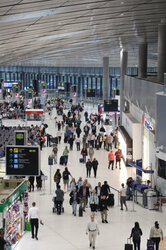
Secure, sustainable and reliable fiber network at Tocumen Airport

Decision to use fiber optics made in the last minute
The plans for the construction of the new terminal were already well advanced when Ricardo Quintero took over the IT management of Tocumen Airport in 2015. From the very beginning, the structured cabling of the building with copper cables had been planned in the traditional way. However, an article about the successful implementation of the FTTO concept at Dubai Airport made him doubt the structured cabling for this project. The manager put the decision for a copper-based network to the test and scrutinized it in terms of sustainability, costs and security. His evaluation was clear: FTTO technology was convincing in all respects. This is also confirmed by Abdy Sanjur, the airport's current CIO: “FTTO technology was not only an efficient and more cost-effective solution for us during construction. Today, it offers us the flexibility to expand the network at any time and to integrate additional terminals or new services. Tocumen Airport is growing continuously, and these options are essential for us.”

Significantly reduced space requirement
Airports are spacious, and long distances have to be covered both within the passenger areas and in the cargo areas. The two current terminals at Tocumen Airport alone cover an area of more than 190,000 square meters, and the construction of a third terminal is currently being planned. At the same time, the length restriction for the Ethernet copper cables (twisted pair) used in the tertiary area is 90 meters. As a result, the initially planned structured cabling would have taken up a lot of space. On the one hand due to the space required for the copper cables themselves, and on the other hand for the technical rooms required for the sub-distribution in the respective segments. Additional repeaters would have required a power supply and a corresponding protected housing. Conclusion: a great deal of effort, an enormous space requirement and therefore significantly high costs overall.
The FTTO concept, on the other hand, is significantly leaner and more fail-safe: the network has a star-shaped and redundant structure. The compact micro switches are connected to two central technical rooms via the two integrated fiber optic uplinks. There they are connected to the central Cisco switches via MICROSENS Layer 2 distribution switches. If one connection fails, the micro switch can communicate via the second connection at any time. Four standard RJ45 copper interfaces are available on each Micro Switch for cost-effective connection of end devices.

Robust switches for outdoor areas
The FTTO network at Tocumen Airport is by no means limited to the terminals themselves; hardware must also be connected in the outdoor areas. With a relative humidity of between 75 and 90 percent in Panama City, this places an enormous strain on the switches. This is where the airport relies on the MICROSENS Ruggedized Micro Switches and robust Gigabit Ethernet Switches from the Profi Line Modular (PLM) series. Both solutions have been specially developed for harsh environments and exceptional loads - including high humidity - and offer extended temperature ranges, for the PLM series this is between -40 and +75 degrees Celsius, so that smooth operation can also be guaranteed in non-temperature-controlled environments.
Overall, the installation team had to overcome a number of hurdles. For example, all cables and switches in the passenger areas were installed concealed and in some cases attached to an installation rail on the roof at a height of 20 meters. In areas subject to increased stress, the switches and some of the cable ducts were made of metal to provide additional protection against external influences.

Efficient network management
A network of this size requires straight forward network management and a competent IT team. The IT security of Tocumen Airport is the focus for Abdy Sanjur, and the efficient management of the network is a crucial prerequisite for this. “The NMP Enterprise software from MICROSENS makes our work significantly easier. We have an overview of the components in our FTTO network at all times and can react quickly if necessary. Thanks to the training and certification of our team at MICROSENS in Germany, we are able to resolve almost all queries internally in the shortest possible time,” says Sanjur. The airport's IT team traveled to Germany in two teams and received first-hand information on the FTTO technology as part of the ‘FTTO Advanced Certificate’. Ivan Dario Salazar, the MICROSENS support engineer in Latin America, assisted the team with tricky questions. The experienced engineer knows the FTTO technology and is a competent contact person for key customers and, above all, for MICROSENS partners in the region.
Successful collaboration
The IT team at Tocumen Airport will continue to rely on the FTTO concept in the future. The upgrade to the next switching generation is currently underway. For new projects - such as equipping new duty-free stores - MICROSENS Layer 3 switches with 10G technology are being installed as central distribution switches. The systems are fully compatible with the predecessor models and can also be managed via the NMP software. Here too, Abdy Sanjur sees enormous advantages of the technology: “Our systems are part of the critical infrastructure and must function smoothly around the clock. The FTTO technology from MICROSENS will continue to offer us the ideal basis for this in the future.”
Sobre MICROSENS
La transmisión de información a través de conexiones de fibra óptica aporta numerosas ventajas. MICROSENS GmbH & Co. KG se dio cuenta de ello muy pronto. Como una de las pioneras, la empresa lleva desarrollando y produciendo sistemas de comunicación y transmisión de alto rendimiento en Alemania desde 1993. Adaptados individualmente a los requisitos de los distintos ámbitos de uso e integrados en conceptos integrales para industrias concretas. Pero, sobre todo, cerca del cliente. Los retos técnicos de los proyectos de los clientes fluyen directamente hacia el desarrollo de los productos. Así es como se crean soluciones de automatización basadas en IP para edificios modernos, conceptos de red rentables para oficinas y centros de trabajo, soluciones robustas y a prueba de fallos para entornos industriales, sistemas de transporte óptico para redes de área extensa orientadas al futuro y el acoplamiento eficaz de ubicaciones y centros de datos.











